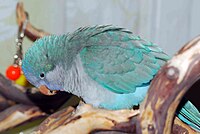Monk parakeet
| Monk parakeet | |
|---|---|
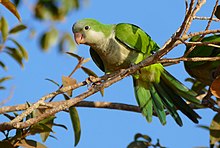
| |
| Scientific classification | |
| Domain: | Eukaryota |
| Kingdom: | Animalia |
| Phylum: | Chordata |
| Class: | Aves |
| Order: | Psittaciformes |
| Family: | Psittacidae |
| Genus: | Myiopsitta |
| Species: | M. monachus
|
| Binomial name | |
| Myiopsitta monachus (Boddaert, 1783)
| |
| Subspecies | |
|
2–4, see text | |

| |
| Synonyms | |
|
Psittacus monachus (Boddaert, 1783) | |
The monk parakeet (Myiopsitta monachus), also known as the monk parrot or Quaker parrot, is a species of
Taxonomy
The monk parakeet was described by French polymath
The monk parakeet is one of two species in the genus Myiopsitta, the other being the
Three subspecies are recognized:[11][9]
- M. m. monachus (Boddaert, 1783) is found in ; it is the largest subspecies.
- M. m. calita (Boddaert, 1783) is found in the Chubut provinces.
- Smaller than monachus, wings more prominently blue, gray of head darker.
- M. m. cotorra (Finsch, 1868) is found in southwestern Río Paraguay and middle Paraná basins, as well as the Gran Chaco. It is essentially identical to M. m. calita, but reported as less yellow below and brighter overall.
The subspecies' ranges meet in the general area of Paraguay, and there they are insufficiently delimited. The distinctness and delimitation of M. m. calita and M. m. cotorra especially require further study.
Like the other
Description

| External audio | |
|---|---|
The
Domestic breeds in colors other than the natural plumage have been produced. These include birds with white, blue, and yellow in place of green. As such coloration provides less camouflage, feral birds are usually of wild-type coloration.
Behaviour and ecology
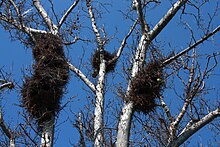


The monk parakeet and the cliff parrot are the only two parrot species that build a stick
Unusually for a parrot, monk parakeet pairs occasionally have helper individuals, often grown offspring, which assist with feeding the young (see kin selection).
The lifespans of monk parakeets have been given as 20–30 years;[13] the former might refer to typical lifespans in captivity and/or in the wild, while the latter is in the range of maximum lifespans recorded for parakeets.
Monk parakeets probably have individual voice prints that allow them to recognize each other, independently from the used call type.[14]
Native distribution
In its native range, the monk parakeet is very common.[1] In Argentina, Brazil, and Uruguay, monk parakeets are regarded as major agricultural pests (as noted by Charles Darwin, among others). Their population explosion in South American rural areas seems to be associated with the expansion of eucalyptus forestry for paper pulp production, which offers the bird the opportunity to build protected nests in artificial forests where ecological competition from other species is limited.[11]
Invasive species


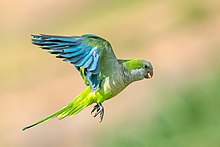
Self-sustaining
In areas where they have been introduced, some fear they will harm
Feral populations are often descended from very small founder populations. Being as social and intelligent as they are, monk parakeets develop some cultural traditions, namely vocal dialects that differ between groups. In populations descended from a large number of birds, a range of "dialects" exists. If the founder population is small, however, a process similar to genetic drift may occur if prominent founders vocalize in an unusual "dialect", with this particular way of vocalizing becoming established in the resulting feral colony. For example, no fewer than three different "dialects" occur among the feral monk parrots of the Milford, Connecticut, metropolitan area.[19]
Brazil
The species has in recent years expanded its range in Brazil, where a self-sustaining population occurs in the downtown area of
Mexico

The monk parakeet was first recorded in Mexico City in 1999.[21] Records exist from seven other locations, including the cities of Puebla, Morelia, Celaya, Oaxaca, Tuxtla Gutiérrez, Hermosillo, and Mexicali, and the mouth of the Loreto River in Baja California Sur.
Nesting populations are known in Mexico City and Oaxaca. A small but growing population has also been established in the southern part of the city of
Following the ban on the trade of native parrot species, local traditional bird sellers have now switched to the monk parakeet as their staple parrot, and that might have increased the number of escapees. Sometimes, the head and breast feathers of monk parakeets are dyed yellow to deceive uninformed buyers, mimicking the endangered yellow-headed amazon. The presence of this species in seven geographically distant and independent locations in Mexico indicates that the source of these individuals is most likely the pet trade.[21]
United States
Thousands of monk parakeets were imported to the United States between the 1960s and the 1980s as pets.
As one of the few temperate-zone parrots, the monk parakeet is able to survive cold climates (partly because they build communal nests about heat-producing electrical equipment atop utility poles), and
New York State
In 2012, a pair of monk parakeets attempted nesting in Watervliet, New York, about 240 km (150 mi) north of New York City, near Albany, New York.[28] Prior to egg-laying, one bird was captured and the nest eventually was removed due to concerns that the nest built adjacent to an electrical transformer created a fire hazard.[29]
They have also found a home in
Chicago
The population in Chicago is estimated to be at 1,000 birds, with healthy colonies located in several of the city's parks.[32] Parrot origin theories include a University of Chicago experiment gone awry,[33] an overturned truck on its way to a pet store,[33] escaped birds from a holding pen at O'Hare Airport[32] or released / escaped pets.[32] According to University of Chicago ornithologist Dr. Stephen Pruett-Jones, "They got here through the pet trade and the pet trade really peaked in the mid- to late 1960s."[33]
The first documented parrot nest in Chicago dates to 1973.[33] The species continues to thrive despite several unusually harsh winters that occurred during the 1980s and in 2014.[32] Various attempts to remove them were made over the years, most of which were resisted by a group of Hyde Park residents, including Mayor Harold Washington.[34] The birds are generally welcomed in the city, especially by bird watchers, and were the subject of a 2012 ornithological study.[32]
-
Two Quakers in a tree – Florida
-
Monk parakeet nest in League City
-
The large nest in the Green-Wood Cemetery gate
Europe
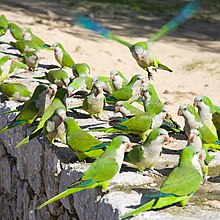
In Spain, monk parakeets can be seen in
In Greece, monk parakeets have established breeding colonies in the National Garden, Athens.[37]
The
Groups of monk parakeets can be found in the Belgian capital city Brussels and its surrounding areas. They have been living in the wild at least since the 1970s.[39]
Populations in
As pets
Monk parakeets are highly intelligent, social birds. Those kept as pets routinely develop
Because of monk parakeets' listing as an agricultural pest, the U.S. states of California, Georgia, Kansas, Kentucky, Hawaii, Maine, New Jersey,[41] Pennsylvania, Tennessee, and Wyoming,[31] as well as Western Australia[42] outlaw their sale and ownership. In Connecticut, one can own monk parakeets, but cannot sell or breed them. In New York and Virginia, one can own monk parakeets with banding and registration. In Ohio, owning one is legal if the bird's flight feathers are clipped or it is incapable of free flight.[31][43]
-
Pet with blue mutation
-
Pets with yellow mutation
References
- ^ . Retrieved 19 November 2021.
- ^ Buffon, Georges-Louis Leclerc de (1780). "La perruche souris". Histoire Naturelle des Oiseaux (in French). Vol. 11. Paris: De L'Imprimerie Royale. pp. 206–207.
- Daubenton, Louis-Jean-Marie (1765–1783). "Perruche à poitrine grise". Planches Enluminées D'Histoire Naturelle. Vol. 8. Paris: De L'Imprimerie Royale. Plate 768.
- ^ Boddaert, Pieter (1783). Table des planches enluminéez d'histoire naturelle de M. D'Aubenton : avec les denominations de M.M. de Buffon, Brisson, Edwards, Linnaeus et Latham, precedé d'une notice des principaux ouvrages zoologiques enluminés (in French). Utrecht. p. 48, Number 768.
- ^ Peters, James Lee, ed. (1937). Check-list of Birds of the World. Vol. 3. Cambridge, Massachusetts: Harvard University Press. p. 200.
- ^ Bonaparte, Charles Lucien (1854). "Tableau des perroquets". Revue et Magasin de Zoologie Pure et Appliquée. 2nd. 6: 145–158 [150].
- ^ a b Gill, Frank; Donsker, David, eds. (2019). "Parrots, cockatoos". World Bird List Version 9.2. International Ornithologists' Union. Retrieved 11 August 2019.
- ISBN 978-1-4081-2501-4.
- ^ ISBN 1-873403-40-2.
- ^ South American Classification Committee (9 January 2008). "A classification of the bird species of South America (Part 3: Columbiformes to Caprimulgiformes)". Archived from the original on 9 January 2010. Retrieved 12 January 2008.
- ^ ISBN 84-87334-22-9.
- ^ a b Amorim, James Faraco; Piacentini, Vítor de Queiroz (2006). "Novos registros de aves raras em Santa Catarina, Sul do Brasil, incluindo os primeiros registros documentados de algumas espécies para o Estado" [New records of rare birds, and first reports of some species, in the state of Santa Catarina, southern Brazil] (PDF). Revista Brasileira de Ornitologia (in Portuguese and English). 14 (2): 145–149. Archived from the original (PDF) on 17 December 2008. (electronic supplement Archived 17 December 2008 at the Wayback Machine, PDF)
- ^ Kamuda, Melinda L. (19 March 1998). "Quaker parrots (a.k.a. monk parakeets) care and training". Archived from the original on 28 January 1999. Retrieved 12 January 2008.
- PMID 37800160.
- ^ List of birds of British Columbia
- ^ "The Mysterious Story of the Green Parrots in Düsseldorf | Life in Düsseldorf". 20 December 2018.
- ^ "Monk Parakeets in Singapore". Bird Ecology Study Group. 22 February 2013. Retrieved 8 January 2021.
- ^ "Defra to remove problem monk parakeets from wild". BBC News. 24 April 2011. Retrieved 25 April 2011.
- S2CID 86107569.
- ISBN 978-85-61368-00-5.
- ^ a b "Pretty, but dangerous! Records of non-native monk parakeets (Myiopsitta monachus) in Mexico" (PDF). Revista Mexicana de Biodiversidad. 82: 1053–1056. 2011.
- Audubon Society. Retrieved 9 December 2016.
- New York Times News Service. Archived from the originalon 20 December 2016. Retrieved 9 December 2016.
- ^ "Austin's wild monk parakeets search for new home". austinot.com. 26 February 2016.
- ^ Clark, By Gary (11 December 2015). "Monk parakeets are a fun, outdoor surprise". Houston Chronicle. Retrieved 12 May 2019 – via HoustonChronicle.com.
- ^ "Parakeets: The enduring mystery at Dallas' White Rock Lake". 13 September 2018.
- ^ "Wild parrots escaped into this N.J. town 30 years ago and they never left". nj.com. December 2019.
- Albany Times Union. Retrieved 22 February 2015.
- Albany Times Union. Hearst. 30 June 2012.
- ^ Powell, Michael (28 December 2006). "Parrots have colonized the wilds of Brooklyn". The Washington Post. Retrieved 12 January 2008.
- ^ a b c "Why are Quaker Parrots Illegal in Some States".
- ^ a b c d e Kuykendall, Mark (2014). "Chicago's subtropical parrots thrive in Chiberia". Medill Reports. Chicago, IL: Northwestern University. Retrieved 20 May 2014 – via news.medill.northwestern.edu.
- ^ a b c d Bobeda, Tricia (29 August 2013). "Chicago: A home fit for wild parrots". WBEZ.com. Retrieved 27 August 2019.
- The Chicago Tribune. Retrieved 27 August 2019.
- ^ Planelles, Manuel (12 November 2015). "Monk parakeets now seen as a plague in major Spanish cities". Diario El País. Retrieved 27 December 2020.
- ^ Ansede, Manuel (5 June 2018). "Así se llenó España de cotorras". Diario El País (in Spanish). Retrieved 3 August 2018.
- ^ "A real urban "jungle"". Greek Birding (blog). January 2013.
- ^ Gray, Louise (25 April 2011). "Wild parakeets living in Britain to be shot before they become a nuisance". The Daily Telegraph. Archived from the original on 27 April 2011. Retrieved 5 May 2011.
- ^ a b
- Borowski, Zbigniew; Zub, Karol; Jacob, Jens (8 March 2019). "Applied research for optimized vertebrate management: 11thEuropean Vertebrate Pest Management Conference". S2CID 73506310.
- This review cites this research.
- Postigo, Jose-Luis; Strubbe, Diederik; Mori, Emiliano; Ancillotto, Leonardo; Carneiro, Inês; Latsoudis, Panagiotis; Menchetti, Mattia; Pârâu, Liviu G; Parrott, Dave; Reino, Luís; Weiserbs, Anne; Senar, Juan Carlos (April 2019). "Mediterranean versus Atlantic monk parakeets Myiopsitta monachus : towards differentiated management at the European scale". Pest Management Science. 75 (4): 915–922. S2CID 58646054. Retrieved 10 April 2023.
- Borowski, Zbigniew; Zub, Karol; Jacob, Jens (8 March 2019). "Applied research for optimized vertebrate management: 11thEuropean Vertebrate Pest Management Conference".
- ^ "The Vocabulary of a Quaker Parrot". Archived from the original on 27 September 2007. Retrieved 12 January 2008.
- Bergen Record. Retrieved 18 May 2023.
- ^ "Parrot intercept a reminder to check import rules". Western Australia Department of Agriculture and Food. 8 October 2010. Archived from the original on 8 February 2013.
[...] a monk parakeet, a prohibited species which is not permitted to be imported into or kept in WA.
- ^ "Are Quakers Legal in My State?". Quaker Information Center. 31 December 2004. Archived from the original on 8 October 2007. Retrieved 12 January 2008.
Further reading
- Bolognini, Marco (2021). Quaker Parrots: Caring - Breeding - Selection - Mutations. Italy. ISBN 979-8712199440.)
{{cite book}}: CS1 maint: location missing publisher (link - Athan, Mattie Sue; Davey, JoAnn; Davey, Jon-Mark (2004). Parrots in the City: One Bird's Struggle for a Place on the Planet. Framingham, Massachusetts: Quaker Parakeet Society. ISBN 1-59113-563-X.
- Johnson, Steve A.; Logue, Sam (2009). "Monk Parakeet (Myiopsitta monachus)". Florida's Introduced Birds. University of Florida/IFAS.
- Field Guide to the Birds of North America. Washington, D.C.: ISBN 0-7922-6877-6.
- ISBN 0-679-45122-6.
- "Monk Parakeet". All About Birds. Cornell University. Retrieved 21 April 2020.
External links
- Monk parakeet entry in the World Parrot Trust's Parrot Encyclopedia
- Guide to ageing and sexing (PDF) by Javier Blasco-Zumeta and Gerd-Michael Heinze
- Time lapse photography showing a pet monk parakeet constructing a nest on YouTube
Information on monk parakeets as introduced species
- Monk parakeet news from around the world
- Naturalized Parrots in the U.S.
- Monk parakeet factsheet from the University of Florida/IFAS
- BrooklynParrots.com, a website about monk parakeets in Brooklyn
- The Parakeet of City Streets, an article on introduced monk parakeets on 10000birds.com
Information on monk parakeets as pets
- Quaker Parakeet Society website
- The Quaker Parakeet Handbook, a guide to keeping monk parakeets as pets
- QuakerVille, a forum for monk parakeet owners





